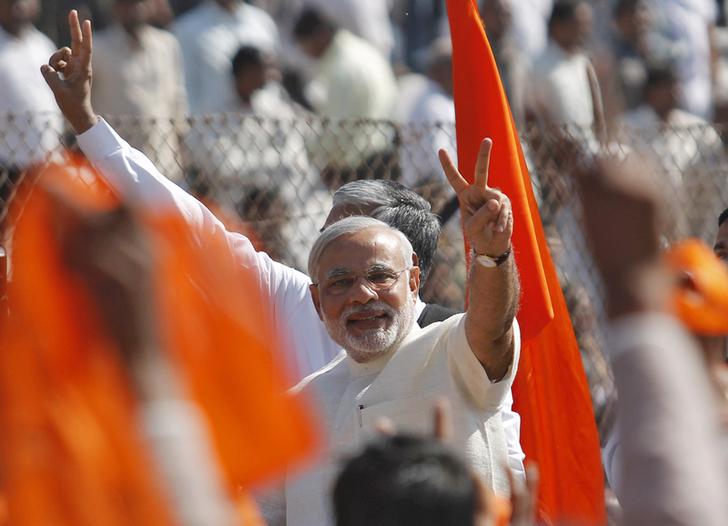The ruling Bharatiya Janata Party (BJP), which has just won a landslide victory in the parliamentary polls, is not resting on its laurels and preparing for even larger goals toward the next general election in 2024.
“Mission 333” and “Make the BJP a truly pan-India party” are the driving force behind this year’s country-wide membership drive, formally launched by Prime Minister Narendra Modi himself in his constituency of Varanasi last week, according to senior party officials. Such membership drive is conducted by the party every three years.
333 is the target of the Lok Sabha (lower house of parliament) seats that the party aims to win in 2024. The house has a total strength of 543 elected members. The party currently has a strength of 303, while they won 282 seats in the 2014 elections. Sunil Deodhar, the party’s national general secretary, explained, “the Mission 333 can be possible only if the BJP overcomes the perception of being a party of and for `Hindi’ speakers.”
“Our core mandala is from West Bengal to Tamil Nadu and to make inroads for 2024, if we have to reach our 333 mark, then we will have to focus on these states along the coast line,’’ said the key strategist in an interview to the Hindustan Times.
BJP strategy for the south where regional parties ruled the roost?
Senior party strategists, Shivraj Singh Chauhan, the head of the membership drive and former Chief Minister of Madhya Pradesh, national general secretaries Ram Madhav, Deodhar and Muralidhar Rao and Rajya Sabha Member G.V.L. Narasimha Rao have descended on south India to take charge of the matters.
The party is fast spreading its wings on the state of Andhra Pradesh. It wanted to teach a lesson and deface the existence of its former ally, the local Telugu Desam party (TDP). The latter was earlier part of the BJP’s NDA alliance, but split complaining that the central government denied “special status” to the newly formed state. Its chief, Chandra Babu Naidu, spearheaded a national movement to unite regional and splinter parties under the leadership of the Congress party to defeat Narendra Modi and the BJP.
The party sees an opportunity there. The ruling TDP lost the state elections to its rival regional `YSR Congress party’. The TDP, with its worst ever performance of winning just 23 seats in the 176-member assembly, is in a shock and disarray. Many of its elected members and other leaders seem to be ready to quit the party and join the YSRCP or the BJP.
During their whirlwind tour of the state, the BJP leaders provided further clues to their strategy to win the next elections in the states starting from November this year in Mizoram to the general elections in 2024.
Ram Madhav, the top national strategist for a number of trouble spots including Jammu and Kashmir and North-eastern states, stated at a party meeting in Vijayawada (Andhra Pradesh) that the Congress party is crumbling itself, thanks to its own “inept” leader, Rahul Gandhi who needs no help in the process from the BJP.
The party workers only have to create a right atmosphere to gain the confidence of the people and a trust in the Modi government to deliver good governance and all-round development, he added. Regional popular leaders will be roped in as the party’s structure is being built in the southern states from scratch, including appointment of booth level committees for continuous interactions with voters.
The BJP’s aim in Andhra Pradesh in the next two years is to emerge as a formidable and responsible opposition and then march on to capture power in the elections in 2024. Many of the senior leaders from the TDP, Congress and other smaller groups are said to be queuing up to join the BJP. The party has taken up the membership drive in all seriousness, with its national head himself performing symbolic cleaning of the feet of senior citizens joining the party.
In adjoining Telangana too, where the unrivaled TRS party decimated all opposition, the BJP is able to rope in senior leaders of the weakened Congress party and dissidents from the TRS, whose numbers are still a sprinkle but slowly gathering momentum. Financial backers of the party are raided by income tax authorities, a strategy so brazenly used by the BJP in other states as well, including Andhra Pradesh and Karnataka. The party had won 4 of the 17 parliamentary seats in the recent elections, which is a significant gain.
The BJP is the single largest party in the Karnataka state assembly but could not muster enough support to form the government there. The ruling alliance of the Congress party and the regional JDS remained shaky since its inception a year ago and its collapse is in the offing with a major chunk of Congress party members resigning to join the BJP, creating an opportunity for the latter to capture power.
There is growing disenchantment with the ruling Communist Party in Kerala state, whose support base is shifting to the Congress after a recent controversy over the entry of women of a certain age group into a local temple. The BJP’s strategy is to lure these shifting caravans to its camp. The Tamilnadu politics do not allow domination of any national party in the state and the latter have to ride on the back of one of the two regional parties, which take power by turns. While the BJP claims to hold its alliance with the ruling AIADMK party, it has kept its options open to tie up with the rival DMK party if need be.
Is the BJP over confident?
Notwithstanding the confidence effused by the party leaders, the BJP continues to be seen in Andhra Pradesh as the villain which denied the state its rightful share of developmental assistance. The newly elected YSRCP too got a negative response from Modi’s government to its request for `special status’ to the state. The BJP’s admission of TDP’s tainted leaders, who are facing criminal charges of cheating banks and revenue investigations, is not making the party dearer to the people. The party’s claim of exodus of the TDP leaders and workers is nowhere to be seen despite promises of potential nominative positions of the central government.
The TDP is slowly recovering from its initial shock and able to regroup in the face of verbal and physical onslaught by the ruling YSRCP cadres. Some TDP leaders, who had originally come from the YSRCP, like to return to their parental party for immediate benefits, if any, but their doors are temporarily closed. They do not seem to be eager to join the BJP as they do not see it as a viable alternative to the TDP or YSRCP, which among them command about 90 per cent of voting share. The BJP polled only 0.9 per cent in the state in this year’s election. Young educated voters admire Prime Minister Modi but it will be a herculean task for the party to enlist support of the masses.
The Vokkaliga community dominates the political arena in Karnataka and is the backbone of the JDS party. The party is a formidable force ruling the state independently or in coalition with the Congress or the BJP for the most part of the last two decades. As long as the Congress party remains weak, the BJP will have an advantage in Karnataka and marginal gains in Telangana. The Congress party, both at the national and state levels, has become moribund but the capacity of the Grand Old Party to revive cannot be underestimated.




